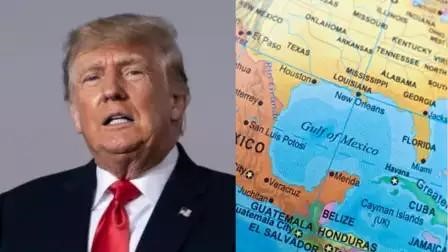Trump Proposes Renaming Gulf of Mexico ‘Gulf of America
Why in the news?
Donald Trump suggested renaming the Gulf of Mexico as the “Gulf of America,” citing U.S. contributions to trade and energy. This sparked humorous rebuttals and historical reflections, with experts highlighting the challenges of renaming maritime regions internationally.
Trump’s Proposal to Rename Gulf of Mexico:
- Donald Trump proposed renaming the Gulf of Mexico to the “Gulf of America,” linking it to the U.S.’s contributions to trade and energy.
- Mexican President Claudia Sheinbaum countered humorously, suggesting “Mexican America” as a nod to 17th-century maps.
- This sparked a debate, though renaming would require international consensus.
Historical Context of Naming
- The name “America” originates from explorer Amerigo Vespucci, whose writings described a “New World.” A German mapmaker labeled the region “America” in
- Mexico’s name derives from the Aztec language Nahuatl: metztli (moon), xictli (center), and -co (place), symbolizing Tenochtitlan, the core of modern Mexico City.
- The Gulf of Mexico was named by Spanish explorers in the 16th century and holds significant historical and economic importance for the U.S.
Can the Gulf Be Renamed?
- Renaming the Gulf of Mexico is not a unilateral decision; it involves international organizations like the International Hydrographic Organisation (IHO).
- Disputes over naming maritime regions, like the South China Sea, highlight complexities in such changes.
- The Gulf is vital for U.S. energy, contributing 14% of its crude oil and 5% of its natural gas production. Over 48% of petroleum refining occurs along its coast.
- Historically, no major U.S. politician has suggested renaming the Gulf until Trump.
About Yucatán Peninsula:
- Located in Northeastern Central America, bordered by the Gulf of Mexico (west and north) and Caribbean Sea (east).
- Composed mainly of coralline and porous limestone rocks.
- Known for its low-lying terrain and unique geological formations, including cenotes (sinkholes).
- Covers parts of Mexico, Belize, and Guatemala.
- Home to significant Mayan archaeological sites, such as Chichén Itzá and Tulum.
- Plays a key role in separating the Gulf from the Caribbean, connected via the Yucatán Channel.
Sources Referred:
PIB, The Hindu, Indian Express, Hindustan Times




